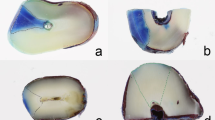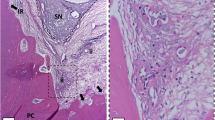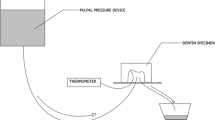Abstract
Attempts have been made to treat dentinal hypersensitivity by sealing exposed dentinal tubules, and the carbon dioxide (CO2) laser has been shown to have a sealing effect on dentinal surfaces. The purpose of this study was to analyze the morphological ultra-structure and temperature change after CO2 laser irradiation of dentin. Fourteen human third molars were selected and cleaned. An area was delimited, and the samples were randomly divided into seven groups: Group 1 (G1): control; G2, calcium hydroxide paste (CA) + CO2 laser (L) (0.5 W/63,69 W/cm2); G3, CA + L (1 W/125,38 W/cm2); G4, CA + L (1.5 W/191,08 W/cm2); G5, L (0.5 W); G6, L (1 W); G7, L (1.5 W). All irradiation was performed in unfocused mode. The electron micrographs were analyzed by three observers. For temperature analysis, a thermocouple was used. Data were subjected to statistical analysis. The Kruskal–Wallis non-parametric test showed statistical differences between the groups (P < 0.05). For the two by two comparisons, all groups treated with calcium hydroxide paste presented significantly higher mean scores. In the groups treated by CO2 laser only, fusion, re-crystallization, cracks and carbonization were observed. A change of 1 ± 5°C was noted in the temperature. Under the limitation of an in vitro study, and with the protocols used, we concluded that CO2 laser is safe to use for the establishment of partial fusion and re-solidification of the dentinal surface.









Similar content being viewed by others
References
Yoshiyama M, Niori Y, Ozaki K, Uchida A, Ishikawa Y (1990) Transmission electron microscopic characterization of hypersensitive human dentin. J Dent Res 69:1293–1297
Yoshiyama M, Suge T, Kawasaki A, Ebisu S (1996) Morphological characterization of tubule-like structure in hypersensitive human radicular dentin. J Dent 24:57–63
Orchardson R, Gillam DG (2006) Managing dentin hypersensitivity. J Am Dent Assoc 137:990–998
Pashley DH (1986) Sensitivity of dentin to chemical stimuli. Endodont Dent Traumatol 2:130–137
Jacobsen PL, Bruce G (2001) Clinical dentin hypersensitivity: understanding the causes and prescribing a treatment. J Contemp Dent Pract 2:1–8
Bartold PM (2006) Dentinal hypersensitivity: a review. Aust Dent J 51:212–218
Tanji EY, Matsumoto K (1994) The comparative study of the morphological changes of dentin surface after Nd:YAG, CO2 and argon lasers irradiation. J Jpn Endod Assoc 15:14–20
Yonaga K, Kimura Y, Matsumoto K (1999) Treatment of cervical dentin hypersensitivity by various methods using pulsed Nd: YAG laser. J Clin Laser Med Surg 17:205–210
Wakabayashi H, Hamba M, Matsumoto K, Tachibana H (1993) Effect of irradiation by semiconductor laser on responses evoked in trigeminal caudal neurons by tooth pulp stimulation. Lasers Surg Med 13:605–619
Birang R, Poursamimi J, Gutknecht N, Lampert F, Mir M (2007) Comparative evaluation of the effects of Nd:YAG and Er:YAG laser in dentin hypersensitivity treatment. Lasers Med Sci 22:21–24
Ling TYY, Gillam DG (1996) The effectiveness of desensitizing agents for the treatment of cervical dentin sensitivity. A review. J West Soc Periodontol Periodontal Abstr 44:5–12
Zhang C, Matsumoto K, Kimura Y, Harashima T, Takeda F, Zhou H (1998) Effects of CO2 laser in treatment of cervical dentin hypersensitivity. J Endod 24:595–597
Olsson H, Petersson K, Rohlin M (2006) Formation of a hard tissue barrier after pulp cappings in humans. A systematic review. Int Endod J 39:429–442
Moritz A, Gutknecht N, Schoop U, Goharkhay K, Ebrahim D, Wernisch J, Sperr W (1996) The advantage of CO2-treated dental necks, in comparison with a standard method: results of an in vivo study. J Clin Laser Med Surg 14:27–32
Moritz A, Schoop U, Goharkhay K, Aoid M, Reichenbach P, Lothaller MA, Wernisch J, Sperr W (1998) Long-term effects of CO2 laser irradiation on treatment of hypersensitive dental necks: results of an in vivo study. J Clin Laser Med Surg 16:211–215
Misra V, Mehrotra J, Dixit J, Maitra SC (1999) Effects of a carbon dioxide laser on periodontally involved root surface. J Periodontol 70:1046–1052
Steiner-Oliveira C, Rodrigues LK, Soares LE, Martin AA, Zezell DM, Nobre-dos-Santos M (2006) Chemical, morphological and thermal effects of 10.6-microm CO2 laser on the inhibition of enamel demineralization. Dent Mater J 25:455–462
Sasaki KM, Aoki A, Masuno H, Ichinose S, Yamada S, Ishikawa I (2002) Compositional analysis of root cementum and dentin after Er:YAG laser irradiation compared with CO2 laser and intact roots using Fourier transformed infrared spectroscopy. J Periodont Res 5:50–59
Zach I, Cohen G (1965) Pulp response to externally applied heat. Oral Surg Oral Med Oral Pathol 19:515–530
Grossman LI (1935) A systematic method for the treatment of hypersensitive dentin. J Am Dent Assoc 22:592–602
Pashley E, Horner H, Liu M, Kim S, Pashley D (1992) The effects of CO2 laser energy on dentin permeability. J Dent Res 71:162
Luomanen M, Hemmerlé J, Voege CJ, Rauhamaa R, Meurman JH (1998) Transformation of hydroxyapatite to fluorapatite with CO2 laser irradiation. Proceedings of the 6th International Congress on Lasers in Dentistry. International Society for Lasers In Dentistry, Maui, Hawaii, pp 72–73
Lan WH, Chen KW, Jeng JH, Lin CP, Lin SK (2000) A comparison of the morphological changes after Nd:YAG and CO2 laser irradiation of dentin surfaces. J Endod 26:450
Acknowledgements
The authors wish to express their gratitude to the Special Laboratory of Lasers in Dentistry (LELO) at the University of São Paulo, Brazil. They thank the Fundação de Amparo à Pesquisa do Estado de São Paulo (FAPESP) for financial support, the Mestrado Profissionalizante de Lasers em Odontologia (MPLO; Professional Master’s Course in Lasers in Dentistry) and Fundação para o Desenvolvimento Científico e Tecnológico da Odontologia (FUNDECTO; Foundation for the Scientific and Technological Development of Dentistry) for the use of the CO2 laser.
Author information
Authors and Affiliations
Corresponding author
Rights and permissions
About this article
Cite this article
Romano, A.C.C.C., Aranha, A.C.C., Lopes da Silveira, B. et al. Evaluation of carbon dioxide laser irradiation associated with calcium hydroxide in the treatment of dentinal hypersensitivity. A preliminary study. Lasers Med Sci 26, 35–42 (2011). https://doi.org/10.1007/s10103-009-0746-4
Received:
Accepted:
Published:
Issue Date:
DOI: https://doi.org/10.1007/s10103-009-0746-4




